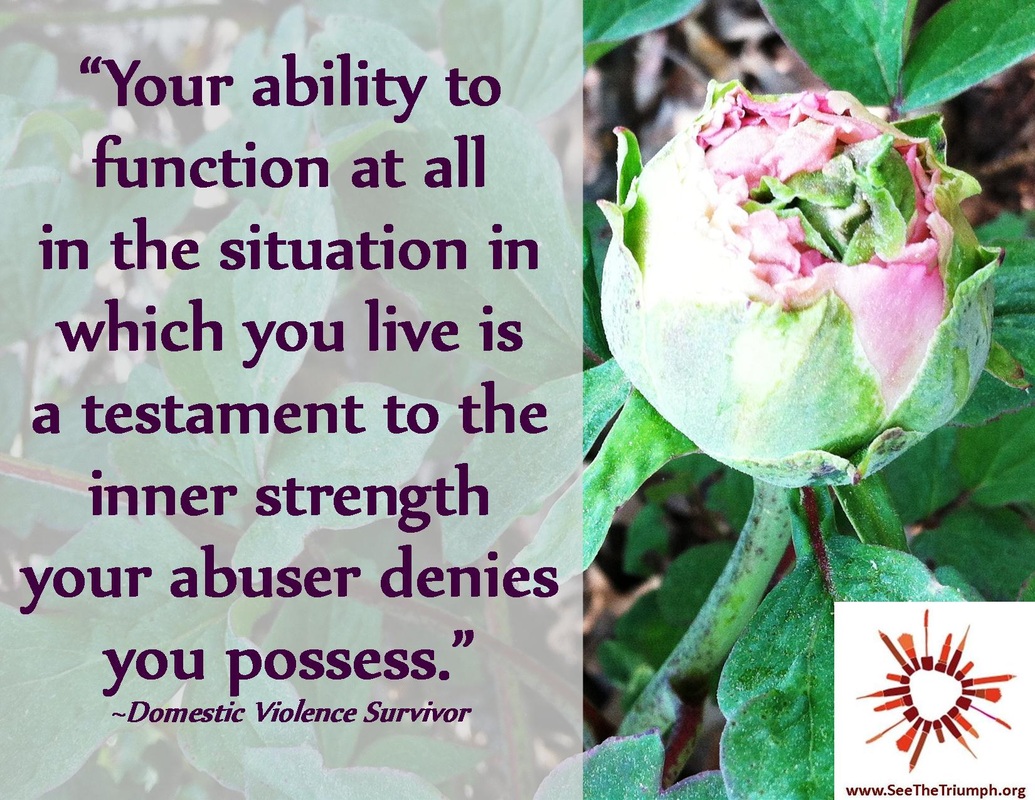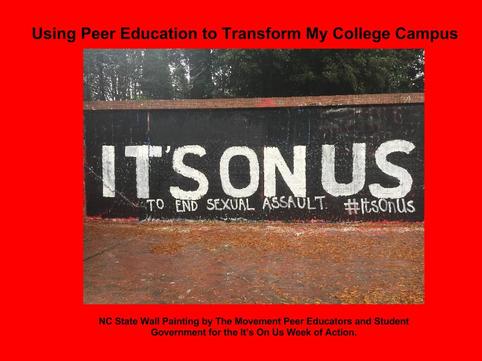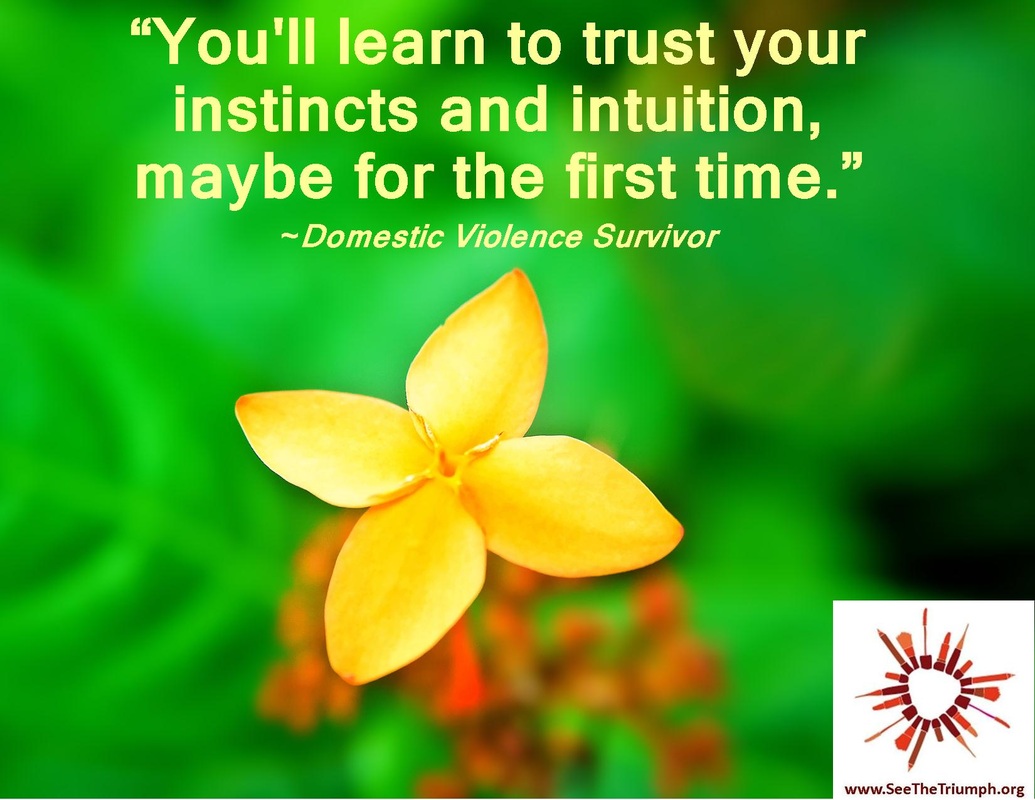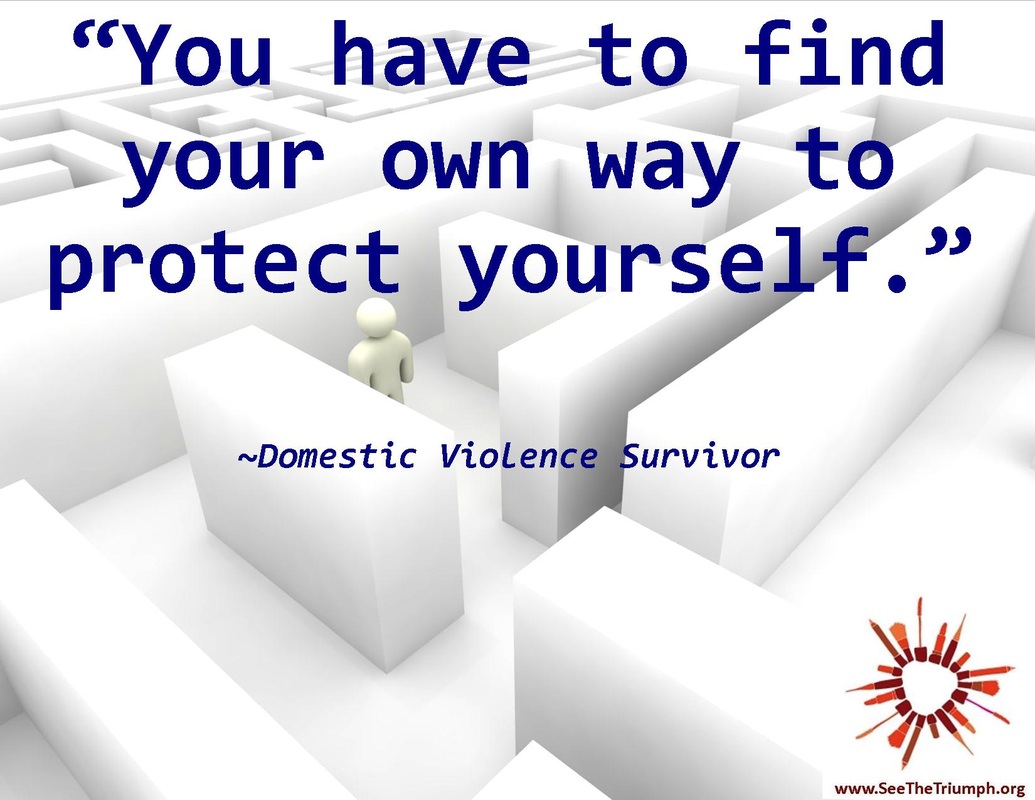|
Catherine Johnson, See the Triumph Guest Blogger For over ten years, a systemic approach to addressing issues of family violence has been sprouting across the nation. This approach looks at community violence at the macro-level using a three pronged approach, which includes collaboration amongst law enforcement, prosecution, and social support services. The Family Justice Center (FJC) model is transforming how services are delivered, making big waves not only in developing a coordinated community response to violence but also in better supporting those individuals and families seeking safety. The FJC model is a nationally recognized multidisciplinary approach that brings together professionals, under one roof, to provide better coordinated, streamlined, and integrated services. There are currently over 80 operating centers and over 100 communities in some stage of the planning for a FJC or similar co-located, multidisciplinary approach across the country and the world. The founders are the FJC model often say, "Dream Big, Start Small". As the first director of the Guilford County Family Justice Center in North Carolina, these words ring ever true. How does a community dream about how life could be different for survivors of domestic and sexual violence? How does one imagine a community where survivors feel safe and supported by "the system"? How do we engage the private, government, and corporate sectors to invest in a new approach to responding to the epidemic of family violence? Big questions, right? Here in Guilford County, a group of dedicated professionals and community members have been charting a new course, dissecting the complex social issue of family violence at the systemic level, one step at time. As a licensed marriage and family therapist, I often relate my work with FJC collaborative partners to that of family counseling. One unique component of family work, particularly when a lot of family members are present in session, is that inevitably someone will spill the beans, name the elephant in the room, and expose the problems in the family. Families challenge one another; shine a spotlight on the good, bad, and ugly, while also adamantly resisting change. This dynamic also presents itself in collaborative work. FJC partners challenge one another and address complex issues, all while having a shared responsibility to make the community safer. Our collaborative partnership consists of folks from the medical, legal, law enforcement, educational, social services, and non-profit sectors. Just as the services provided are diverse, so are our relationships and partnerships. We are dreaming big...visioning a better way to give hope to hurting families. We are talking to those actively seeking safety and those who have done so in the past and soliciting feedback and suggestions for ways to improve our community's response. We are educating our community on being more fully engaged in addressing violence and calling each person to take action. Our work is evolving as we move from simply exchanging information to harmonizing our efforts and activities. Together, we are enhancing our capacity, and in doing so, lives are being changed. Radical things are happening. The collaborative energy, passion and dedication to improve the wellness and safety of this community is palpable! The synergy is electric and the momentum for change is like a fast-moving locomotive. Get on board and contribute to the big dream of living in a community that has eradicated violence in all forms.  Catherine Johnson is the first Director of the Guilford County Family Justice Center (FJC), a new public safety initiative through Guilford County that is designed to bring professionals together under one roof to provide coordinated collaborative services to victims of domestic violence, sexual assault, child maltreatment, and elder abuse victims. Previously, Catherine worked as the Director of Crisis Intervention Services for Family Services of Davidson County located in Lexington, NC. Catherine has over seven years of experience working with survivors of domestic violence and sexual assault. Catherine is a licensed marriage and family therapist in North Carolina and received master’s degree from the University of North Carolina at Greensboro. Catherine’s professional career has been dedicated to working with families impacted by violence and abuse. Her current focus is on developing strategies for creating systemic change in an effort to reduce violence and empower survivors. By Sara Forcella, See the Triumph Contributor Dealing with issues like domestic violence and sexual assault is never easy. Working on a college campus adds an entirely new dynamic into the picture. In the short time that I’ve been working at a large, public university, I’ve learned that not everybody is as concerned with these issues as me. In fact, some students will graduate and never think twice about stalking, rape, or partner violence--although I’m sure it’s in some way affected them, even if they don’t realize it. My job as an educator and as a self-identified activist is to change the perception that students have about these issues. It’s my prerogative that all students--no matter their race, sex, gender identity, sexual identity, etc.--should leave with an understanding of gender-based violence. They should know what it looks like, how it affects others and our society, and most importantly how they can help work toward ending it. My day-to-day job consists of talking to students about things like sexual assault and partner violence, but there’s so much more that needs to be said and heard. Even though I talk to students on a one-on-one level, in small groups, and in even in large classrooms filled with 150 students, my words can’t reach all 35,000 students at my university. That’s where my group of campus leaders comes in! Through our university’s Women’s Center, we have a group of trained peer educators who go out and facilitate workshops to student groups like Greek Life, Resident Halls, classes and much more. This group is called “The Movement.” The great thing about this group is not only their passion for issues of social justice and gender equity, but their ability to relate to their peers. Who better to speak to a group of sorority sisters about sexual violence than 2 fellow female students? These students go to similar classes, dine at the same dining halls, live in the same residence halls and understand current issues in college life in a way that I never can or will considering my age difference with traditional-aged college students.
The really great thing about using peer educators to teach about issues of gender-based violence is that the folks who attend workshops actually care. Students care about other students! There's a sense of comradery that I, as an educator, can't achieve. Workshops facilitated by peers also create a really safe space for other students. There they are able to ask seemingly ‘silly’ questions, and they even can be confrontational and disagree. I believe that any contribution to the conversation is good as long as the conversation is happening! Our peer educators are trained, so they know how to deal with conflict and potentially triggering subjects. We consistently receive great feedback about our facilitators and their commitment to the issue. It’s my hope their their passion, commitment, and words will help instill the same passion in other students and open their minds to issues that are critical to talk about. 1/27/2015 Love Your Technology WiselyBy Kaofeng Lee, See the Triumph Guest Blogger In the work that I do, every day we hear horrific stories of how perpetrators use technology to stalk, harm, and harass victims. One would think I hate technology, but I don’t. I love technology. While technology can be misused to harm, it can also be used for good. Because we also hear of how service providers are using technology in innovative and transformative ways to support survivors, whether it’s through education via an app or through an awareness raising campaign on social media. There is power in technology, and service providers – and survivors – are using it to empower themselves. As we consider ways in which technology can be used to help survivors, it’s important to keep a few principles in mind. 1. Safety First. When developing innovative tools, always keep in mind that each survivor’s situation is unique, and what may be safe for one survivor may not be for another. Respect survivor’s privacy and choices. For example, many programs are considering new methods for how survivors can reach out for help, such as texting or chatting, but they’re doing so with thoughtful consideration for survivors’ safety and privacy as well as their own obligations to protect survivors’ confidentiality. 2. Technology is a tool, not a solution. Be careful not to offer a false sense of security by implying that a particular technology will make someone safer. Technology can facilitate better communication, offer access to services or help, or educate people about abuse, but the technology itself will not stop sexual assault or end domestic violence. Apps that not only educate users about healthy and respectful relationships but offers realistic, tangible resources so survivors can get help are great. 3. Place accountability with the abuser. There’s a thin line between giving survivors tools and options and burdening them with the responsibility of managing their victimization. Technology that encourages survivors to document their assaults, create a circle of friends who can come to the rescue, or push a button to create a loud noise to frighten the attacker can be helpful for some survivors, but they remind me of telling women to carry rape whistles or mace. It’s important to not perpetuate the idea that a survivor can control and even prevent abuse or assault. 4. If survivor’s technology is compromised, don’t take it away. Technology is a big part of our lives: it allows us to connect with friends and family, it entertains us, and it keeps us current on what’s happening in the world. Survivors use their technology for all those reasons as well, and even if someone is using their technology to stalk or harass them, the solution isn’t for them to give up their technology but to learn how to use it wisely: safely and privately. For more resources on how survivors can use their technology in safe and private ways, visit http://techsafety.org/resources-survivors. We also have handouts specifically for service providers on how they can use technology effectively and safely. Check out our suggestions on best practices here: http://techsafety.org/resources-agencyuse.  Kaofeng Lee is a Deputy Director of the Safety Net Project at the National Network to End Domestic Violence (NNEDV). Kaofeng advocates on behalf of survivors of interpersonal violence by educating others on how technology can be misused to stalk and harass. She also provides trainings, resources, and other technical assistance to increase the knowledge and capacity of victim’s advocates so they can help those in need. Before joining NNEDV, Kaofeng was a bilingual advocate for a local domestic violence program, edited for a publications and design agency, and provided project management for a top 5 accounting firm, where she learned that listening is most important, the Oxford comma should be king, and obsessing over details is totally okay. Kaofeng has a Masters in International Relations from American University and a Bachelor of Arts in Journalism and Communication from Iowa State University. By Barry Goldstein, See the Triumph Guest Blogger The ACE (Adverse Childhood Experiences) Studies contain medical research from the Centers for Disease Control originally used by doctors to diagnose and treat patients with health problems caused by childhood abuse inflicted decades earlier. The findings have even greater value for prevention and have the ability to transform society in the most joyous and consequential ways. The ACE Research demonstrates that children exposed to domestic violence, child abuse and other traumas will live shorter lives with far more illness and injury. Domestic violence is at the epicenter of adverse childhood experiences. The long-term health risks are caused by living with stress from the fear engendered by abusers. The essence of domestic violence is the fear and intimidation used by domestic abusers to coerce their partners to do what they want. Fathers who abuse mothers are 40-60% more likely to also physically abuse children. Domestic violence is also associated with all of the other ACEs. Preventing domestic violence will therefore dramatically reduce health and safety risks for children thus reducing cancer, heart disease, stroke, mental illness, suicide, substance abuse, crime and many other social problems. Put more positively, the prevention of domestic violence will lead to a healthier, happier and wealthier society where women and children can be safe in their homes. Domestic Violence is Not Inevitable Domestic violence has been dramatically reduced in places like Quincy, Nashville and San Diego by using a group of proven practices. In Quincy, District Attorney Bill Delahunt noticed that virtually every inmate in a nearby high security prison had a childhood history that included domestic violence and often sexual abuse. He believed that if he could prevent domestic violence he could reduce all crime and this is exactly what happened. A county that averaged 5-6 homicides enjoyed several years with no murders. I have updated the successful practices to create the Quincy Solution. The essence of the original responses were strict enforcement of criminal laws, protective orders and probation rules together with practices that made it easier for victims to leave their abusers and a coordinated community response. I have added the new research and technology like GPS that were not available when these communities enjoyed their success. In Quincy, some victims stopped cooperating with prosecutors when their abusers sought custody. This did not derail the success because at the time this was a rare tactic. Today this is a standard abuser tactic. They routinely seek custody as a way to regain control over their victims and undermine domestic violence laws. Accordingly the custody courts must be part of the Quincy Solution and stop allowing abusers to use the courts to gain custody or access to the children. The Safe Child Act which requires courts to make the health and safety of children the first priority in all custody and visitation decisions is part of the Quincy Solution. Huge Financial Benefits for Ending Domestic Violence I have worked in the movement to end domestic violence for over 30 years so I would agree to spend almost any sum to stop hearing the horrific stories. I don’t want to read about the mothers and children killed by abusers or police officers murdered when they try to stop him. I hate the stories of courts ripping children from safe, loving mothers and forcing them to live with abusers and rapists. Most people are less aware of these tragedies and so other issues are given greater priority. For me, the world changed when I read about the health costs related to domestic violence. Previous estimates were limited to the costs of treating the immediate wounds from an assault and believed the cost was $5-8 Billion annually in the United States. The ACE research demonstrates the full costs include the many diseases and social problems caused from the stress of living with an abuser. The full cost is $750 billion. When we also consider crime costs and the loss of economic potential the cost is well over one trillion dollars annually. Based on the success in communities like Quincy, Nashville and San Diego, I believe the best practices would quickly save $500 billion annually and that will be a huge incentive for policy makers to adopt the Quincy Solution. Conclusion Fifty years ago, the U.S. Surgeon General released a report linking cancer and smoking. It was depressing to know that our tolerance and encouragement of smoking led to so many illnesses and deaths and enormous medical costs. Society responded with laws, commercials, taxes, cessation programs and other practices to discourage smoking. As a result smoking has been reduced and this has led to reductions in cancer and heart disease, longer lives and reduced healthcare costs. Behavior that we now refer to as domestic violence and child abuse has been allowed and encouraged for thousands of years. Our present life expectancy and frequency of many common and deadly diseases are based on the existing level of domestic violence and child abuse. Fortuitously the knowledge of the full benefits from preventing abuse occurs just when the Quincy Solution demonstrates our ability to dramatically reduce domestic violence. We have the ability for the first time in human history to make most women and children safe from domestic violence. But just as domestic violence is not inevitable, neither is the Quincy Solution. We need people who care to get involved and make sure this opportunity is not lost. Join the Stop Abuse Campaign and encourage organizations in which you belong to join the coalition. Speak and write to legislators, community leaders, the media and friends about the Quincy Solution and Safe Child Act. Promote a meeting in your community so the public can learn about our ability to prevent domestic violence. I will be traveling around the country to speak about the Quincy Solution and hope organizations will invite me to speak. Together we can have a safer world.  Barry Goldstein is a nationally recognize domestic violence author, speaker and advocate. He is the author of some of the leading books about domestic violence and custody including Domestic Violence, Abuse and Child Custody, co-edited with Dr. Mo Therese Hannah, Representing the Domestic Violence Survivor, co authored with Elizabeth Liu and Scared to Leave Afraid to Stay. His latest book, The Quincy Solution: Stop Domestic Violence and Save $500 Billion demonstrates we have the ability to dramatically reduce domestic violence based on proven practices. 1/22/2015 Moving Away from Blaming the VictimBy Heather Teater, See the Triumph Contributor What was she wearing? Was she drinking? Didn’t she know better than to walk home alone at night? Was she asking for it? What does she do that provokes him to beat her like that? Why doesn’t she stand up for herself? Doesn’t she think about her kids? Why doesn’t she just leave? Whether talking about sexual assault or intimate partner violence, for a long time we, as a society, have been asking the wrong questions. Though our previous efforts have been well-intentioned, they focused too much on potential victims and what they could do to not be assaulted and not enough on potential perpetrators. Recently, however, we have started to see a shift in initiatives designed to prevent sexual assault and domestic violence. These campaigns have moved from asking people to make special efforts to protect themselves to encouraging people not to perpetrate. As individuals, we need to remember to do the same. If you are talking to someone who has been victimized (whether you are a friend, family member, helping professional, or a total stranger) it’s important to remember not to ask the wrong questions. Asking questions about the victim’s role in the situation can insinuate that they are in some way responsible for what happened to them, which only perpetuates victim-blaming. Even in our everyday lives we can change the conversation around these issues. Whether or not you are not having a direct conversation with someone who has been victimized, be aware of the way that you think and talk about sexual assault and intimate partner violence. For example, how do you respond when someone talks about a recent news story regarding domestic violence? Do you join others in asking why the woman who was victimized would ever stay with her husband, or do you steer the conversation toward why her husband became violent in the first place? We need to take responsibility for our own biases and responses to stories about sexual assault and domestic violence before we can expect the rest of society to do the same. When we have our own biases in check, we can move on to initiating, participating in, promoting, and otherwise involving ourselves in campaigns to end domestic violence and sexual assault. We need more initiatives that focus on sending the messages “do not rape” and “do not abuse” rather than “do not let yourself be raped or abused.” We can start by helping such programs get introduced in our own communities. If you’re not sure how to get your own initiative started in your community, there are campaigns in place that already have a focus on educating potential perpetrators and they would love to become involved in your area by providing educational materials, organizing rallies, giving presentations, etc. Some examples of such campaigns are Break the Cycle, Men Can Stop Rape, and A Call to Men, among many others. We can end sexual assault and domestic violence. It starts with changing the conversation our society is having about these issues, asking the right questions, and keeping our focus on those responsible – the perpetrators, not the survivors.  Heather Teater recently completed her Master's degree in Couple and Family Counseling in the Department of Counseling and Educational Development at the University of North Carolina at Greensboro. |
Archives
July 2024
CategoriesAll About Intimate Partner Violence About Intimate Partner Violence Advocacy Ambassadors Children Churches College Campuses Cultural Issues Domestic Violence Awareness Month Financial Recovery How To Help A Friend Human Rights Human-rights Immigrants International Media Overcoming Past Abuse Overcoming-past-abuse Parenting Prevention Resources For Survivors Safe Relationships Following Abuse Schools Selfcare Self-care Sexual Assault Sexuality Social Justice Social-justice Stigma Supporting Survivors Survivor Quotes Survivor-quotes Survivor Stories Teen Dating Violence Trafficking Transformative-approaches |
Search by typing & pressing enter









 RSS Feed
RSS Feed